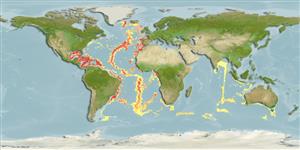Common names from other countries
>
Aulopiformes (Grinners) >
Ipnopidae (Deep-sea tripod fishes) > Ipnopinae
Etymology: Ipnops: Greek, hypnos = sleep + Greek, ops = appearance (Ref. 45335).
More on author: Günther.
Environment: milieu / climate zone / depth range / distribution range
Ecologia
marinhas batidemersal; intervalo de profundidade 1789 - 3477 m (Ref. 26165). Deep-water
Eastern Indian Ocean: Australia. Western Atlantic: Mid Atlantic Bight and Bahamas. Eastern Atlantic: northwest Africa. Also known in Pacific Oceans (Ref. 26165).
Tamanho / Peso / Idade
Maturity: Lm ? range ? - ? cm
Max length : 13.2 cm SL macho/indeterminado; (Ref. 26165)
Descrição breve
Chaves de identificação | Morfologia | Morfometria
Raios dorsais moles (total) : 8 - 10; Raios anais moles: 13 - 16; Vértebras: 54 - 58.
Inhabits the continental slope (Ref. 7300). Maximum depth from Ref. 58018.
Life cycle and mating behavior
Maturities | Reprodução | Spawnings | Egg(s) | Fecundities | Larvas
Paxton, J.R., D.F. Hoese, G.R. Allen and J.E. Hanley, 1989. Pisces. Petromyzontidae to Carangidae. Zoological Catalogue of Australia, Vol. 7. Australian Government Publishing Service, Canberra, 665 p. (Ref. 7300)
Categoria na Lista Vermelha da IUCN (Ref. 130435)
CITES (Ref. 128078)
Not Evaluated
Ameaça para o homem
Harmless
Utilização humana
Ferramentas
Relatórios especiais
Descarregue XML
Fontes da internet
Estimates based on models
Preferred temperature (Ref.
115969): 2.9 - 4.5, mean 3.4 (based on 587 cells).
Phylogenetic diversity index (Ref.
82804): PD
50 = 0.6250 [Uniqueness, from 0.5 = low to 2.0 = high].
Bayesian length-weight: a=0.00102 (0.00046 - 0.00225), b=3.06 (2.88 - 3.24), in cm Total Length, based on all LWR estimates for this body shape (Ref.
93245).
Nível Trófico (Ref.
69278): 3.1 ±0.32 se; based on food items.
Resiliência (Ref.
120179): Médio, tempo mínimo de duplicação da população 1,4 - 4,4 anos (Preliminary K or Fecundity.).
Fishing Vulnerability (Ref.
59153): Low vulnerability (10 of 100).
